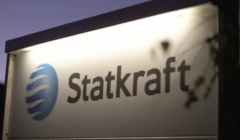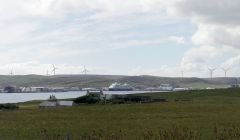Energy / No more wind projects for Statkraft but hydrogen remains firmly on the radar
The energy firm is continuing to look at sites in Shetland for possible green hydrogen production
THE DEVELOPER behind three proposed local wind farms has confirmed it does not have plans for any more in Shetland.
Meanwhile Statkraft continues to look at sites in Shetland for possible green hydrogen production.
However, one of its hydrogen project managers, Brie Foster, confirmed at a media briefing on Tuesday that nothing has been signed and sealed yet regarding using land near the former Scatsta Airport site for hydrogen production.
Discussions have been taking place between landowner Shetland Islands Council and Statkraft plus partners regarding leasing land around the disused Scatsta Airport.
Shetland News also revealed earlier this year that Statkraft was exploring the potential of a site outside of Lerwick for hydrogen production.
Beyond that though Statkraft said it was unable to say much more publicly regarding its plans for hydrogen in Shetland.
“We are actively looking at sites in Shetland at the moment,” Foster said.
“These projects are at early feasibility stage I would say, so we’re undertaking technical feasibility work to ensure that we are developing the right size of technology, the right technology and in the right locations as well.
“We’re also in the process of undertaking agreements with landowners and securing those deals.
“I think once those are secured we’d probably feel in a more comfortable position to be speaking a bit more openly about the projects.”
Statkraft has consent for three onshore wind farms in Shetland – Mossy Hill on the outskirts of Lerwick and Beaw Field and Energy Isles in Yell.
Become a member of Shetland News
Statkraft’s principal wind project manager John Thouless said the three wind projects in Shetland would represent a local spend of around £40 million.
He added that they would cost Statkraft around £2 million a year in non-domestic rates as well.
The Norwegian state-owned company anticipates there being around 30 local jobs during construction across the three wind projects, and six full-time roles during operation.
Statkraft has committed itself to the established £5,000 community per megawatt community benefit scheme, which would equate to around £1.2 million a year across the three sites – but nothing has been confirmed yet about how this would be delivered.
Thouless also confirmed that it is open to “community buy-in” with its wind projects – which could, hypothetically, see a community organisation own some turbines.
While the plans for hydrogen are much less in the open, Statkraft did not rule out the idea of its onshore wind projects powering green hydrogen production in Shetland.
Green hydrogen is produced by using renewable energy to electrolyse water and split it into hydrogen and oxygen.
Asked whether the two Yell wind farms – which may only get a grid connection from 2030 – could power hydrogen production at Scatsta, Thouless said “all options are on the table” at the moment, but no decisions have been made.
He also would not rule out Statkraft redesigning the 17-turbine Beaw Field wind farm; like Mossy Hill, that was initially developed number of years ago by another company – Peel Energy – before being sold on in 2023.
He confirmed that the three wind farms have capacity effectively booked on the 600MW HVDC cable, which will allow renewable developments to export power to the national grid.
The near-completed Viking Energy wind farm in Shetland’s Central Mainland has a total generating capacity of 443MW, with Energy isles up to 126MW, Beaw Field up to 72MW and the revised Mossy Hill set to reach up to 36MW.
However, a second 1.8GW HVDC link between Shetland and the Scottish mainland has now been mooted, although a key driver behind this is offering an export route for energy produced by offshore wind farms proposed to the east of Shetland.
Meanwhile Foster said Statkraft aims to have between 1GW and 2GW of hydrogen production across its global assets by 2035. For the UK, that figure is 500MW.
Foster said she felt Shetland was a prime location for hydrogen production, partly due to renewable resources like wind but also skills and resources already in the isles due to the historic links with oil and gas.
“We really see Shetland as a great opportunity for green hydrogen projects, and see it being at the forefront of this UK energy transition,” she said.
Regarding why Scatsta has been pinpointed as a possible location, Foster added: “It’s a brownfield site, so it’s previously developed, so it’s always good for us.
“It’s got a good distance from any local towns, and there’s access to the deep-water port as well, which is quite beneficial, so that’s why it’s an interesting site to us.”
She said the hope is that before the end of the year Statkraft could be in a position to speak more openly about at least one hydrogen project.
At the nearby Sullom Voe Terminal, operator EnQuest is also exploring hydrogen production at the site as the focus begins to shift away from oil and gas and travel more towards new energy opportunities.
Become a member of Shetland News
Shetland News is asking its readers to consider paying for membership to get additional perks:
- Removal of third-party ads;
- Bookmark posts to read later;
- Exclusive curated weekly newsletter;
- Hide membership messages;
- Comments open for discussion.
If you appreciate what we do and feel strongly about impartial local journalism, then please become a member of Shetland News by either making a single payment, or setting up a monthly, quarterly or yearly subscription.









































































